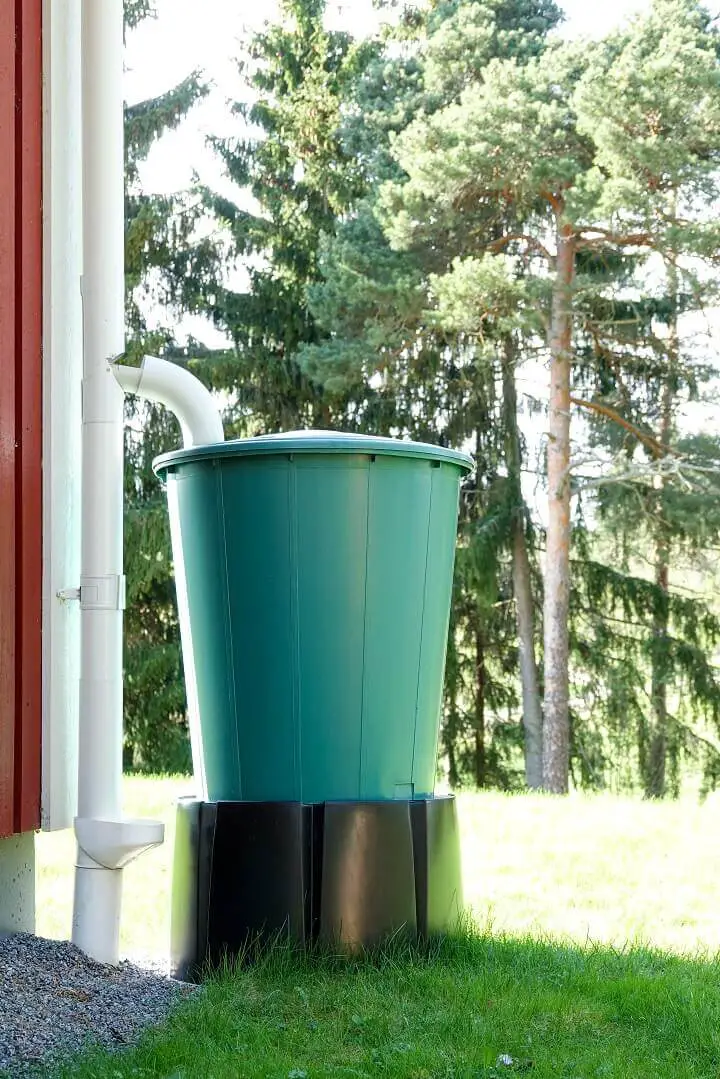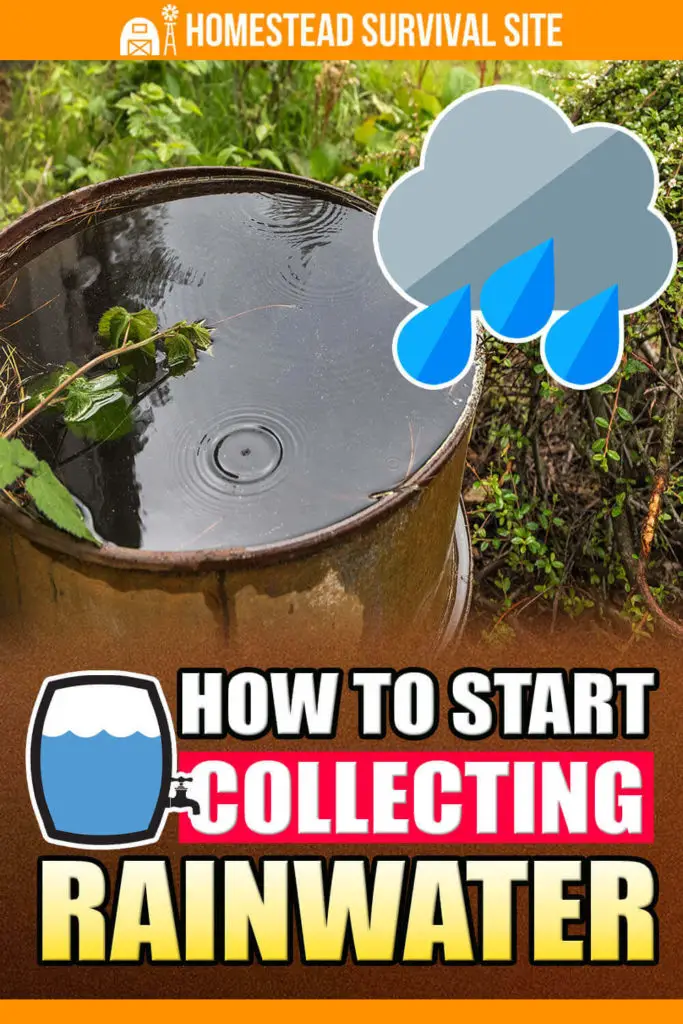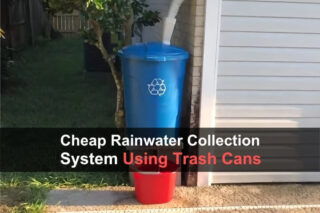Estimated reading time: 8 minutes
We drink it. We cook with it. We swim in it. We clean and wash with it. And we irrigate our gardens with it. Water is essential to our very existence. Yet many of us take it for granted and waste large quantities of it every day.
Collecting and storing rainwater is one way to protect this precious resource. Whether you harvest a lot or a little, this practice can serve as a step on your way to a more sustainable way of life. This article will discuss the basics of rainwater harvesting and offer some tips for setting up a collection system on your homestead.
Want to save this post for later? Click Here to Pin It On Pinterest!
Collecting Rainwater from the Roof
Getting started with a roof collection system is easier than you might think. If you have a gutter and downspout system, much of the work is done already.
In most gutter systems, the water either flows into pipes below the ground or spills out onto the ground a short distance away from the exterior of your home. Before the next rain, be sure to clean your gutters thoroughly, removing any leaves or debris that could be blocking the flow of the water.
This article has some useful DIY tips for beginning rainwater harvesters. And here is a video for a simple roof set-up. In the video below, the homeowner uses inexpensive food-grade barrels.
Rain Barrel or Storage Tank
After cleaning your gutters, the next step is to cut the downspout above ground level and insert it into the top of the rain barrel or storage tank. A rain barrel or tank with a tap on its side is handy for accessing the water you've collected.
The size of the tank you get depends on your budget, the size of your roof, and your climate. Check out these products to give you an idea of what is available.
If you get frequent rainfall throughout the year, you may need fewer and smaller tanks. As you use the water, the tanks will refill with the periodic rain. However, if your area tends to get more occasional but heavier downpours, you may need larger tanks.
If you live in an area that has a rainy season and is dry the rest of the year, you’ll likely need a combination of sizes to harvest as much water as you can. Sizes range from 50-gallon barrels to 5,000-gallon water tanks and even beyond.
Many homesteaders connect multiple containers together with pipes at the bottom, allowing them to overflow into each other. When push comes to shove, you can even bring five-gallon buckets and trash cans onto the scene. However, here are the basic components of any rain harvesting container.
- An inlet or downspout to direct the rainwater into the tank (generally on the top and covered with a screen).
- An outlet that allows you to dispense the water (generally near the bottom). For large tanks, you’ll want a hose bib as well.
- Non-transparent material to block sunlight.
- Fine-mesh screens over all openings.
Soaker Hose or Irrigation Pipes
Another option is to connect the downspouts on your home (or even the tap on your collection container) to a soaker hose or an irrigation pipe. With this method, you can direct the rainwater from your roof toward a garden area.
Hydroponic or Aquaponic System
A third collection option is to direct the roof water into a hydroponic or aquaponic system. With a hydroponic system, you grow plants with their roots in water rather than soil. In an aquaponic system, you grow fish as well as plants.
Collect Rainwater From Outbuildings
You can use any of these methods to harvest rainwater from sheds, barns, or other outbuildings on your homestead. You just may need to install a gutter system so that the water runs gently downward toward a downspout and into your barrel or tank.
You can even collect rainwater from a polytunnel or a greenhouse (see the video below). If you want to be creative, you could even rig a system that directs inside to water the plants growing there.
Related Article: 4 Ways To Collect Water Off the Grid
Storing Rainwater
Collecting the rainwater is one thing, but keeping it around for later use is something else.
Steerage containers vary in cost, material, and size, depending on your needs, goals, and budget. A 50-gallon barrel might work well for one homeowner, while another may need a 15,000-gallon tank for their farm animals and crops.
Similarly, distribution systems can be as simple as filling up a bucket or attaching pumps and drip irrigation systems.
You could consider installing a rainwater storage tank inside a covered growing area. The tank will catch and store the sun’s heat during the day and release it slowly during the night, thereby improving the thermal mass in a greenhouse.
In arid areas, a clay pot irrigation system is an option to consider (see the video below). When filled with harvested rainwater, porous vessels (like clay pots) provide edible plants with the moisture they need.
Making Your Garden More Water-Friendly
If you live in an area prone to drought, you know how frustrating it is to watch precious rainwater runoff in a heavy downpour. In addition to collecting water from the human-made structures on your property, you may also be able to collect and direct rainwater that falls directly on the ground to your growing areas.
Digging mulch-filled ditches or swales can allow you to direct heavy rainfall or snowmelt to specific locations. Another idea is to create an irrigation channel that flows into a holding area, creating a small reservoir. If you have the room, a small pond can be useful as a back-up water supply in emergencies, such as wildfires.
An important step is to recognize the natural capacity plants, trees, and certain soils have for water storage. Trees and other plants can store a surprising amount of rainwater. Their roots also help keep water in the ground, and they provide shade that reduces moisture evaporation.
Choose plants, preferably native plants, that absorb and hold water in their root systems or send it down to the water table rather than allowing it to run off into paved streets or walkways.
What kind of soil do you have in your garden? Heavy, clay soils retain water better than sandy, light soils. No matter what end of the spectrum your soil is on, you can improve its ability to retain moisture by adding organic mulch.

Questions You May Have Before Harvesting Rainwater
How much rainwater will I collect from my roof? Of course, the answer depends upon the amount of rainfall and the size of your roof. However, even in areas with minimal rainfall, you can harvest a surprising amount of water.
According to the Texas Cooperative Extension and the Luling Foundation, you can collect 550 gallons of water for every 1,000 square feet of collection surface per inch of rainfall. To estimate the amount you could collect in one year, take the square footage of your collection surface, divide by 1000, multiply by 550, then multiply by the average annual rainfall for your location.
Are There Restrictions Against Rainwater Collection?
It is not illegal to collect rainwater in any state in the U.S., but some states have restrictions on the amount you can harvest and the method by which you gather it. The reasoning behind these laws is a concern that harvesting could disrupt the natural water table. In some Western states, old water laws still exist that state that all precipitation belonged to existing water-rights owners.
According to research by the Scientific World Journal, the amount of rainwater collected by homeowners has little to no effect on the hydrological cycle, mostly because the water is used on their yards and gardens and thus is returning to the water table.
Virginia, Texas, and Rhode Island encourage residents to harvest rainwater by offering a tax credit or exemption for harvesting equipment. Here is a state-by-state guide on rainwater harvesting restrictions.
Is Collecting Rainwater Worth It?
Only you can answer that. Some people collect rainwater because they feel good about offsetting some of their water use. Others have a desire to be more self-sufficient. Still, others are motivated by an increased risk of wildfire or drought. And some people become so interested in rainwater harvesting that they end up using it as their primary source of water.
As you can see, collecting rainwater is a little more complicated than you might have thought. Be sure to check out our list of mistakes to avoid when harvesting rainwater.
Like this post? Don't Forget to Pin It On Pinterest!













I would not use rainwater at all. It has toxic chemicals from chemtrails in it. There is a guy called DANE WIGINGTON who knows the absolute truth about such things.
We just so happen to have an article on how to remove forever chemicals from rainwater: https://homesteadsurvivalsite.com/how-to-remove-forever-chemicals-from-rainwater/
there are probably more toxic chemicals in your tap than rainwater.